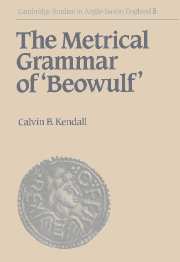Book contents
- Frontmatter
- Contents
- Preface
- List of abbreviations
- List of changes from Klaeber's text
- 1 The Beowulf-poet and his metrical grammar
- 2 The alliterative and metrical principles of Beowulf: Kuhn's ‘laws’ and the transformational rule
- 3 The three kinds of half-lines: extra-metrical alliteration and type A3
- 4 Displacement
- 5 Stressed proclitic adjectives: X-positions and the insertion rule
- 6 Problems with the identification of clause-non-initial half-lines: the proclitic onset
- 7 Half-lines with internal clause divisions: the transformational rule (revised)
- 8 The alliterative requirement of unstressed prefixes and the copulative conjunctions
- 9 The alliterative requirement of prepositions and the proclitic adverbs and instrumentals
- 10 The alliterative requirement of proclitic adjectives and pronouns: the alliterative rule of proclitics
- 11 Displaced and detached proclitics
- 12 The three classes of compounds: the alliterative requirement of class I compounds
- 13 The alliterative behaviour of class II compounds
- 14 The alliterative behaviour of class III compounds and simplexes
- 15 Metrical typology and the metrical grammar
- 16 Conclusions
- Appendix: A typology of the metre of Beowulf in relation to the metrical grammar
- Glossary of technical terms
- Bibliography
- Index of alliteration, scansion and metrical clause structure
- Index of verses specially discussed
12 - The three classes of compounds: the alliterative requirement of class I compounds
Published online by Cambridge University Press: 22 September 2009
- Frontmatter
- Contents
- Preface
- List of abbreviations
- List of changes from Klaeber's text
- 1 The Beowulf-poet and his metrical grammar
- 2 The alliterative and metrical principles of Beowulf: Kuhn's ‘laws’ and the transformational rule
- 3 The three kinds of half-lines: extra-metrical alliteration and type A3
- 4 Displacement
- 5 Stressed proclitic adjectives: X-positions and the insertion rule
- 6 Problems with the identification of clause-non-initial half-lines: the proclitic onset
- 7 Half-lines with internal clause divisions: the transformational rule (revised)
- 8 The alliterative requirement of unstressed prefixes and the copulative conjunctions
- 9 The alliterative requirement of prepositions and the proclitic adverbs and instrumentals
- 10 The alliterative requirement of proclitic adjectives and pronouns: the alliterative rule of proclitics
- 11 Displaced and detached proclitics
- 12 The three classes of compounds: the alliterative requirement of class I compounds
- 13 The alliterative behaviour of class II compounds
- 14 The alliterative behaviour of class III compounds and simplexes
- 15 Metrical typology and the metrical grammar
- 16 Conclusions
- Appendix: A typology of the metre of Beowulf in relation to the metrical grammar
- Glossary of technical terms
- Bibliography
- Index of alliteration, scansion and metrical clause structure
- Index of verses specially discussed
Summary
The alliterative patterns of Beowulf are limited by three sets of conditions – the basic rules of alliteration and metre, the placement of sentence particles and proclitics within the half-line and the nature of the simplex or compound which takes metrical stress. A reader who knows these conditions can predict the potential placement in the a- or b-verse of practically any metrical–syntactical pattern, can say of any given half-line of the poem whether its alliterative behaviour is normal or not and can determine whether, if double alliteration is involved, the double alliteration is a reflex of the metrical grammar or a spontaneous option exercised by the poet. One of the principal objects of this study has been to provide this knowledge. There remain to be discussed the alliterative requirements of compounds.
The compounds which are the subject of this and the following chapter are all stressed elements. Notwithstanding this fact, the alliterative behaviour of these compounds is remarkably varied. Some compounds alliterate no matter where they are found and therefore are not found where the alliterative rules prohibit alliteration. Other compounds alliterate whenever they appear in the a-verse, but occur freely in the second lift of the b-verse without alliteration. And still others are found in the second lift of both the a-verse and the b-verse without alliteration. In short, three classes of compounds can be distinguished on the basis of their alliterative behaviour.
- Type
- Chapter
- Information
- The Metrical Grammar of Beowulf , pp. 159 - 174Publisher: Cambridge University PressPrint publication year: 1991



